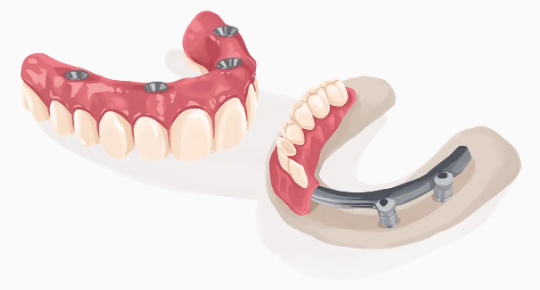
For over 40 years, Dental Implants have offered an exciting long-term solution to the problem of missing teeth. They can replace one or more lost teeth or hold dentures securely in the mouth. The implant takes over the role of the root providing a foundation to which a cosmetic restoration can be secured. Dental Implants have a continuing success rate of 95-98%.

In order to take over the role of the tooth root; the dental implant is inserted into the jawbone under local anaesthetic. It is subsequently interwoven painlessly with bone.
The most natural solution to tooth loss, both aesthetically and functionally is implant-bourne teeth. They are not only fixed as securely as your own natural teeth, but often cannot be distinguished in either function or appearance.
Unlike conventional bridges, when dental implants are placed, the neighbouring teeth do not have to be ground down to stumps in order to support it. Healthy teeth that would be damaged by traditional methods are preserved and there is no risk of tooth decay or problems with tooth roots that may arise with conventional bridges, as long as oral hygiene is maintained.
Dental Implants transmit chewing forces evenly to the jawbone. As with natural teeth, this chewing force stimulates bone and preserves it, halting the bone loss normally associated with missing teeth. Conventional treatment methods do not offer this important benefit.
Implant treatment can be broken down into four phases: treatment planning, implant placement, crown placement and hygiene maintenance. Your dentist will take x-rays and create a model of your existing teeth to determine how the implant should be placed. Occasionally, a bone or gum tissue graft will be needed to provide an adequate site for placement. On occasion, a CT scan is required to fully assess the bone level.
The implant is then placed in the bone and given a period of time to heal (osseointegrate) before attachment of the crown. In some cases, you can receive a temporary crown the same day. The final crown is usually placed 3-6 months after implant placement.
More information about our products: Dental Implants London, Dental Implants Dentist, Teeth implant can be found by contacting us directly.




















Fields with (*) are required.
Please contact us via this website or email without disclosing confidential information.
20 Welbeck Street
London W1G 8ED.
Call us today: 020 7486 8100
Email: info@thewelbeckclinic.co.uk
| Monday | 9.00 am to 6.00 pm |
| Tuesday | 9.00 am to 6.00 pm |
| Wednesday | 9.00 am to 6.00 pm |
| Thursday | 9.00 am to 6.00 pm |
| Friday | 9.00 am to 6.00 pm |